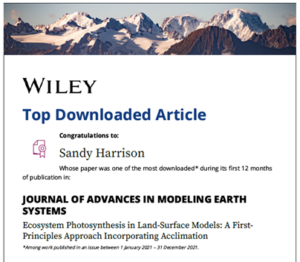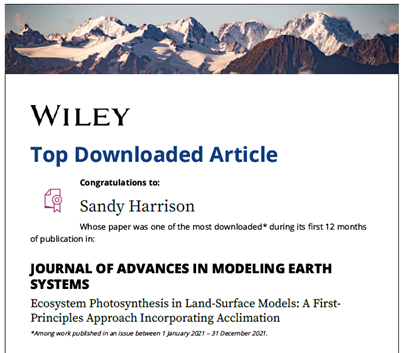Great news to end the month! In the last few days, three LEMONTREE papers have been awarded as the top downloaded papers in both JAMES and New Phytologist.
Eco-evolutionary optimality as a means to improve vegetation and land-surface models. Harrison et al., New Phytologist.
This Tansley review discusses how global vegetation and land-surface models are crucial for predicting the effects of environmental change on vegetation and its interactions with climate. However, these models still have limitations due to persistent differences among carbon and water cycle projections by different models. This review proposes that unifying hypotheses derived from eco-evolutionary optimality principles can provide more parsimonious representations of plant and vegetation processes, which can be tested and supported by evidence. The review presents case studies demonstrating how EEO generates parsimonious representations of core, leaf-level processes that are individually testable and supported by evidence. EEO approaches to photosynthesis, primary production, dark respiration and stomatal behaviour are ready for implementation in global models. Furthermore, this review suggests that independently tested modules emerging from EEO studies could be integrated into modelling frameworks that account for the multiple time scales on which plants and plant communities adjust to environmental change.
You can read our blog here.
Coordination of plant hydraulic and photosynthetic traits: confronting optimality theory with field measurements. Xu et al., New Phytologist
Plants require coordination between water loss and carbon dioxide uptake, which requires the coordination of plant hydraulics and photosynthesis. However, there is limited information on the quantitative relationships between these traits. This study proposes a theoretical framework based on optimality theory and tests its predictions through analysis of measurements on 107 plant species from 11 sites distributed along a 3000m elevation gradient. The study found that hydraulic and leaf economic traits were less plastic and more closely associated with phylogeny than photosynthetic traits. The two sets of traits were linked by the sapwood to leaf area ratio (vH). The study observed coordination between vH and sapwood hydraulic conductivity (KS) and photosynthetic capacity (Vcmax) that conformed to the proposed theory. The research unifies hydraulics, photosynthesis, and the leaf economics spectrum in a common theoretical framework, and suggests a route towards the integration of photosynthesis and hydraulics in land-surface models.
You can read our blog here.
 Ecosystem photosynthesis in land-surface models: a first-principles approach incorporating acclimation. Mengoli et al., Journal of Advances in Modelling Earth Systems.
Ecosystem photosynthesis in land-surface models: a first-principles approach incorporating acclimation. Mengoli et al., Journal of Advances in Modelling Earth Systems.
This paper led by REALM’s Giulia Mengoli with LEMONTREE team members has been recognised as one of the most downloaded papers during its first 12 months of publication in JAMES. Acclimation differs from adaptation, which involves a change in genetic traits to improve performance over generations. LSMs mostly consider rapid changes in photosynthesis in response to environmental changes like temperature and light on short timescales. But we know that plants also adjust their physiology over longer periods within a season. Currently, plant acclimation is not accurately represented in land-surface vegetation models. Mengoli et al. developed a model using optimality theory to balance the optimal trade-offs between various processes such as photosynthesis and characterising plant behaviour while also incorporating acclimation into LSMs. Their new model was able to accurately reproduce the daily cycle of carbon uptake by plants, predict gross primary productivity (GPP) at sub-daily timescales for different vegetation types, and demonstrate that most plants optimise their behaviour for midday conditions. Additionally, the research shows that plants adjust to longer-term environmental variations on a timescale of a week to a month, with an average of 15 days to acclimate.
Link to REALM blog on this paper.
We extend our congratulations to the LEMONTREE team and collaborators for their significant achievement in promoting eco-evolutionary optimality theory and its applications.

